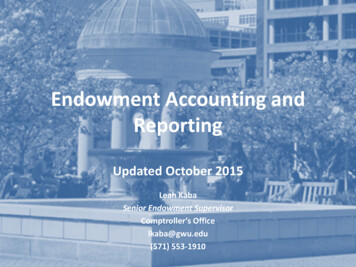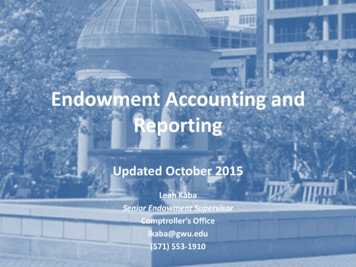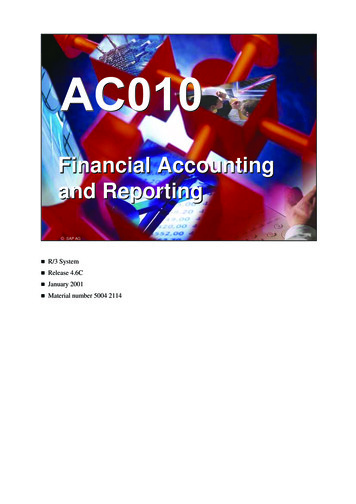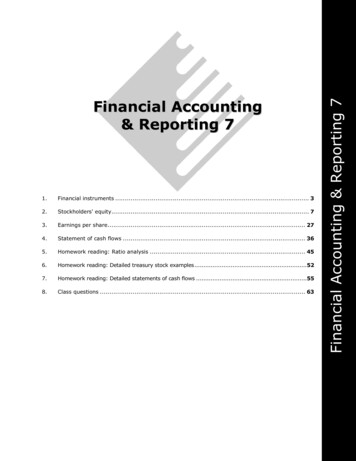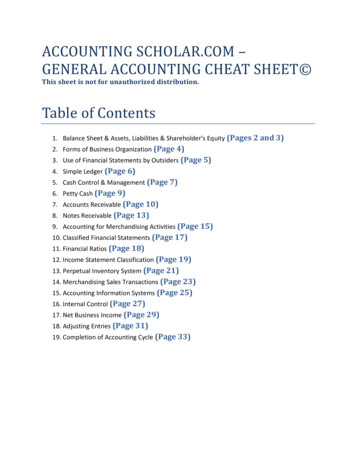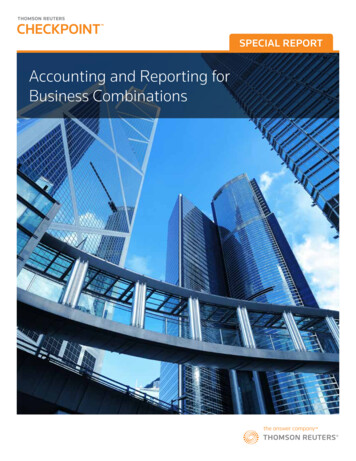
Transcription
SPECIAL REPORTAccounting and Reporting forBusiness Combinations
2SPECIAL REPORT: ACCOUNTING AND REPORTING FOR BUSINESS COMBINATIONSMergers, acquisitions and other types of business combinations are a common strategy amongcompanies that wish to grow their businesses or diversify their risk. Entering into businesscombinations can help companies reach new geographic markets, expand product offerings orachieve various synergies. Business combinations offer a number of benefits to the parties involved,but the initial accounting for the business combination can be complicated and often requiresextensive time and effort.The authoritative accounting and reporting guidance for business combinations under US GAAPis included in Topic 805, Business Combinations, of the FASB Accounting Standards Codification.Topic 805 interacts with other various technical areas of the Codification, such as the guidance onconsolidation (the concept of control), fair value measurements, income taxes and share-basedpayments. Thus, a reporting entity must be familiar with not only Topic 805, but also these othertechnical areas. In addition, SEC registrants must comply with an additional set of rules andregulations for SEC reporting purposes, such as the pro forma disclosures requirements in Rule3-05 of Regulation S-X.One of the challenges that a reporting entity might face in accounting for a business combinationis determining if it has acquired a business or a group of assets. The accounting treatment is verydifferent based on the result of that determination. Another challenge is identifying all of theassets that were acquired and all of the liabilities that were assumed (including intangible assetsand contingencies that the acquired company may not have recorded). Other challenging areasinvolve measuring the assets acquired and liabilities assumed in the business combination atfair value and the resulting goodwill, accounting for adjustments to the initial amounts recordedand determining the tax implications of the acquisition. Many areas of the guidance requiremanagement to make judgments and assumptions. In addition, certain aspects of the accountingare changing, such as the definition of a business and rules for goodwill impairment testing. Areporting entity must stay informed about the ever-evolving guidance.
3SPECIAL REPORT: ACCOUNTING AND REPORTING FOR BUSINESS COMBINATIONSBackground and ObjectivesEach businesscombination isunique. Therefore,the accountingfor each businesscombination maybe different.A reporting entity must ensure that the accounting and reporting for a business combinationreflect the terms of the transaction at hand. Each business combination is unique. Even if areporting entity has undergone a business combination before, there will be new or differentfacts and circumstances to analyze. For instance, some business combinations may involve itemsthat require careful attention, such as intangible assets, contingencies, replacement awards or apreviously-held equity interest, among others. In addition, the measurement of an item acquiredor assumed in the business combination or transferred as consideration is based generally on fairvalue. These fair value estimates depend on market participants’ assumptions about events thathave occurred or exist as of the acquisition date.A reporting entity must ensure that it allocates sufficient resources to understand and address allof the accounting and reporting requirements. Many elements of a business combination requiresignificant management estimates and judgment. A reporting entity may wish to engage theassistance of various experts throughout the process, such as valuation specialists, tax practitionersand legal advisers. A reporting entity also must be able to articulate and support the basis for thejudgments made and conclusions reached in performing the accounting.Business combinations are often examined closely by regulators, investors and other users offinancial statements. Users may raise questions to better understand the economic substance ofthe transaction and regulators may ask a reporting entity to prove that it has complied with theaccounting and reporting requirements. A reporting entity must be prepared to field questionsabout its treatment of a business combination.This special report focuses on the accounting required under US GAAP and is laid out in thefollowing sections: Scope The Acquisition Method Determine the acquirer Determine the acquisition date Recognize and measure the assets, liabilities and noncontrolling interest Recognize and measure any goodwill or gain from a bargain purchase Presentation Disclosure
4SPECIAL REPORT: ACCOUNTING AND REPORTING FOR BUSINESS COMBINATIONSScopeA business combination is a transaction in which an acquirer gains control over a business.To determine if a business combination has happened, an acquirer must first evaluate whetherit has acquired a business or a group of assets. The distinction is critical because the accountingtreatment is very different based on the determination.ASU No. 201701 revises thedefinition ofa business,which maychange whethera transactionis a businesscombination.A transaction is not a business combination unless it involves the acquisition of a business.Therefore, understanding the FASB’s definition of a business is important in order to determine ifthe transaction is a business combination.A business is defined, under US GAAP, as a set of activities and assets that is both self-sustainingand managed to provide a return to investors. A business generally has three elements: inputs,processes and outputs, but a business does not have to include outputs. Also, there is no minimumnumber of inputs or processes required. A set of activities and assets is considered a business aslong as market participants are capable of buying the set and continuing to produce outputs, suchas incorporating the set with their own inputs and processes.OBSERVATION:The FASB definition of a business is not the same as the definition of a business underSEC regulations. Rule 11-01(d) of SEC Regulation S-X indicates that the term business:“should be evaluated in light of the facts and circumstances involved, and whetherthere is sufficient continuity of the acquired entity’s operations prior to and afterthe transactions so that disclosure of prior financial information is material to anunderstanding of future operations. A presumption exists that a separate entity, asubsidiary or a division is a business.”The SEC definition must be used to determine whether reporting under Item 2.01,Completion of Acquisition or Disposition of Assets, of Form 8-K is required for anacquisition transaction. In other words, a reporting entity might have to providehistorical or pro forma financial information under Regulation S-X if an SEC registrantdetermines that a “significant” business acquisition has occurred or is probable, even ifthe transaction is not a business combination under US GAAP.OBSERVATION:In January 2017, the FASB issued Accounting Standards Update (ASU) No. 2017-01,Business Combinations (Topic 805): Clarifying the Definition of a Business. This ASUis effective for public business entities for annual periods beginning after December15, 2017 (and interim periods therein) and for all other entities for annual periodsbeginning after December 15, 2018 (and interim periods after the year of adoption).ASU No. 2017-01 revises the definition of a business under US GAAP by requiring abusiness to have, at a minimum, an input and a substantive process that togethercontribute to the ability to create outputs. This ASU is intended to help entitiesdistinguish between transactions that are business combinations and those that areasset acquisitions. In general, fewer sets of activities and assets will meet the reviseddefinition of a business. Therefore, some of today’s transactions may not qualify as abusiness combination under the new definition.
SPECIAL REPORT: ACCOUNTING AND REPORTING FOR BUSINESS COMBINATIONS5ASU No. 2017-01 provides an initial screen to evaluate if a set of activities and assets is abusiness. The following decision tree illustrates the initial screen.Is substantially allof the fair value of thegross assets acquired (ordisposed of) concentratedin a single identifiableasset (or group of similaridentifiable assets)?YESThe set does notconstitute a businessand no further analysisis necessary.NOAn entity must determine if the setincludes, at a minimum, an input anda substantive process that collectivelycontribute to the ability to create outputs**A market participant is not required to evaluate whether it could replace any missing elements.ASU No. 2017-01 provides a framework to determine if a transaction includes an input anda substantive process. In addition, it gives a more narrow definition of the term “output” tobetter align with the guidance in Topic 606, Revenue from Contracts with Customers.ASU No. 2017-01 must be applied prospectively. Early application is allowed fortransactions that have not been reported in financial statements issued or made availablefor issuance. The following table gives an example of how ASU No. 2017-01 might changean entity’s conclusion of whether a set of activities and assets is a business.FactsPrior to ASU No. 2017-01Under ASU No. 2017-01A real estate entitysells a building withexisting leases. Thesale involves thetransfer of inputs, butnot processes.The transaction might meetthe definition of a businessunder current GAAP becausethe buyer can take the input(the building) and combine theinput with its own processes toproduce outputs (lease income).The transaction does not meetthe definition of a businessunder ASU No. 2017-01 becausethere is no substantive processtransferred.
6SPECIAL REPORT: ACCOUNTING AND REPORTING FOR BUSINESS COMBINATIONSIf an entity acquires assets and liabilities that do not meet the definition of a business, thetransaction is not a business combination. Instead, the entity accounts for the transaction as anasset acquisition under Subtopic 805-50, Business Combinations — Related Issues.OBSERVATION:Understanding the definition of a business is critical to ensure that an entity properlyidentifies transactions as either business combinations or asset acquisitions. Variousdifferences exist between the accounting for business combinations and assetacquisitions. For instance, in a business combination, an entity recognizes goodwill;no goodwill is recognized for an asset acquisition. As another example, in a businesscombination, transaction costs are expensed as incurred. Transaction costs arecapitalized for an asset acquisition. Due to these and other differences, distinguishingbetween business combinations and asset acquisitions is crucial to ensure thata transaction is accounted for properly. Confusing the two can result in materialmisstatements to the acquirer’s financial statements and material errors in thesubsequent measurement of the acquired assets and liabilities.A business combination is accounted for using the acquisition method of accounting. The followingtransactions are often associated with a business combination, but are explicitly excluded from thescope of the acquisition method: Transactions between entities under common control (see Subtopic 805-50) The creation of a joint venture Acquisitions by not-for-profit entities (NFPs) occurring before December 15, 2009 Mergers of NFPs Transactions between NFPs that do not require the consolidation of one NFP by the other (seeFASB ASC 958-810-25-4) The consolidation of a variable interest entity that is a collateralized financing entity
SPECIAL REPORT: ACCOUNTING AND REPORTING FOR BUSINESS COMBINATIONSThe Acquisition MethodUnder Topic 805, an acquirer accounts for a business combination using the acquisition method.The four basic steps in the acquisition method are as follows:STEP 1 — Determine the acquirer.STEP 2 — Determine the acquisition date.STEP 3 — Recognize and measure the assets,liabilities and noncontrolling interest.STEP 4 — Recognize and measure any goodwillor gain from a bargain purchase.STEP 1 — Determine the acquirerStep 1 of the acquisition method is to identify the acquirer. The acquirer is the entity that obtainscontrol of the acquiree.The acquisitionmethod uses thesame conceptof controldescribed in theconsolidationguidance inTopic 810,Consolidation.Factors that may help identify the acquirer include: Who pays cash or other assets as part of the acquisition transaction Who has more voting rights in the combined entity following the acquisition Who holds the largest minority voting interest in the combined entity Who is able to elect, appoint or remove members from the governing body of the combinedentity Who takes the lead in managing the combined entity Who is larger (in terms of assets, revenues, earnings or some other measure) Who initiated the acquisitionOBSERVATION:The Codification does not indicate how to weigh these various factors. At times, certainfactors may point to one party as the acquirer, while others point to the counterparty.For instance, one party might initiate the acquisition, but the other party mighthave more voting rights and management responsibilities in the combined entity. Areporting entity must apply judgment and consider the facts and circumstances, notjust individually, but also in the aggregate.7
8SPECIAL REPORT: ACCOUNTING AND REPORTING FOR BUSINESS COMBINATIONSThe acquirer often is the party that pays cash or other assets as part of the acquisition transaction.An acquirer might obtain control, however, without transferring any consideration. The followingtable provides examples:ExampleDescriptionRepurchase of sharesAn acquiree repurchases a significant number of its own shares. Ifthe number of shares is large enough, this can result in an existinginvestor (the acquirer) obtaining control of the acquiree.Lapse of minority veto rightsAn investor may hold a majority of the voting interest in an investee.If minority veto rights exist, however, these rights prevent theinvestor from having control of the investee. If the minority vetorights lapse, this can result in the investor (the acquirer) obtainingcontrol of the investee.Business combination bycontract aloneTwo parties may agree to enter into a contract to combine theirbusinesses without transferring any consideration, such as astapling arrangement or the formation of a dual-listed corporation.In some cases, the acquirer identified for accounting purposes is different from the legal acquirer.This is called a reverse acquisition or reverse merger. For instance, a reverse acquisition might takeplace if a private company wants to become public without having to register its equity shares.OBSERVATION:Identifying the acquirer of a business combination often is relatively straight forward.It may, however, be more difficult in the case of a reverse acquisition or a businesscombination with no consideration.
SPECIAL REPORT: ACCOUNTING AND REPORTING FOR BUSINESS COMBINATIONSSTEP 2 — Determine the acquisition dateStep 2 of the acquisition method is to determine the acquisition date of the business combination.The acquisition date is the date on which the acquirer obtains control of the acquiree and themeasurement date for recording the assets acquired and liabilities assumed in the transaction. Anacquirer typically obtains control over an acquiree by exchanging consideration, such as: Transferring cash or other assets Incurring liabilities Issuing equity interests Performing a combination of theseIn some cases, an acquirer can obtain control without exchanging any consideration. For example,an acquirer might gain control through a stapling arrangement or as a result of a lapse in minorityveto rights.If an acquirer obtains control of the acquiree over time, in stages, the business combination isreferred to as a step acquisition. For instance, an entity might have a 10% interest in an investee,but no control, and then purchase an additional 50% interest in the investee, gaining control andresulting in a business combination.OBSERVATION:The acquisition date usually is the date at which the acquirer legally transfersconsideration to the acquiree. The acquisition date also might be the closing date forthe contract or another date. All pertinent facts and circumstances must be assessedto identify the acquisition date. An acquirer is encouraged to maintain documentationsupporting its conclusion. Regulators or other users of financial statements sometimesask how the acquisition date was identified.Determining the acquisition date is key because it is the date at which the business combinationis measured. It is also the date that starts the measurement period. During the measurementperiod, an acquirer may be allowed to adjust its initial accounting for the business combination,as described later in this special report. The measurement period exists to give an acquirerenough time to gather the information necessary to account for the business combination. Themeasurement period may extend for a maximum of one year from the acquisition date.9
10SPECIAL REPORT: ACCOUNTING AND REPORTING FOR BUSINESS COMBINATIONSSTEP 3 — Recognize and measure the assets, liabilities andnoncontrolling interestStep 3 of the acquisition method is to recognize and measure the assets acquired, liabilitiesassumed and any noncontrolling interest.Examples of assets and liabilities that might be transferred in a business combination are:AssetsLiabilitiesCash and cash equivalentsAccounts receivableDerivative assetsIndemnification assetsIntangible assets(1)InventoryInvestmentsLease receivablesLoan receivablesProperty, plant and equipmentReacquired rightsContingent assetsDeferred tax assetAccounts payableAccrued liabilitiesAsset retirement obligationsDebtDerivative liabilitiesEnvironmental obligationsIncome taxes payableLease obligationsLiabilities for commitments or contingenciesLiabilities for employee benefits(2)Liabilities for share-based payment awardsContingent liabilitiesDeferred tax liabilities(1) Such as brands, trademarks, patents, customer lists or unrecorded intangible assets used in research and development activities(2) Such as pension or other postretirement benefit plansAll assets acquired and liabilities assumed in a business combination must be recognized bythe acquirer in its financial statements. This might result in the acquirer recognizing an asset orliability that was not previously recognized in the acquiree’s financial statements, such as a brandname, patent, customer relationship or other intangible asset developed internally by the acquiree.The acquirer must recognize 100% of the acquiree’s net assets, even when other parties retain anoncontrolling interest.Various items require judgment to determine if they are part of the business combination. Forinstance, the acquirer and the acquiree may have a pre-existing arrangement or relationship inplace prior to the acquisition; pre-existing arrangements are not part of the business combinationand must be accounted for according to other relevant GAAP. An acquirer also must cautiouslyevaluate transactions to compensate employees (or former owners) of the acquiree for futureservices. The Implementation Guidance and Illustrations in Section 805-10-55 describes variousfactors to consider to determine whether a compensation arrangement is part of the businesscombination and gives related examples. The factors include the terms of the continuingemployment — such as the duration and level of compensation — how the compensation relates toamounts paid to selling shareholders who do not become employees, the number of shares ownedby the employees after the acquisition, how the amount of other consideration transferred in thebusiness combination compares to the valuation of the acquiree, the formula used to determinethe compensation, as well as other arrangements and issues.
SPECIAL REPORT: ACCOUNTING AND REPORTING FOR BUSINESS COMBINATIONS11OBSERVATION:Identifying all of the assets and liabilities exchanged in a business combinationrequires careful attention. An acquirer is encouraged to consider the definitionsof assets and liabilities in FASB Concepts Statement No. 6, Elements of FinancialStatements, as part of its analysis. For areas requiring judgment, the acquirer isencouraged to document thoroughly the basis for its conclusions.A common pitfall is to overlook one or more of the items exchanged, such as anintangible asset or a contingency. Failing to identify and measure one of the itemsexchanged results in the acquirer recording the wrong amount of goodwill. In addition,it results in improper accounting for the item in a future period. For example, if anacquirer overlooks an intangible asset and fails to record it separately, the intangibleasset is recognized as part of goodwill. This results in improper accounting for theintangible asset in future periods because intangible assets must be amortized, and anoverstatement of goodwill, where an overstated goodwill balance may not be assessedproperly for impairment.When identifying all of the assets and liabilities exchanged in a business combination,it is also important not to double count any assets or liabilities. For example, twodistribution channels — that are acquired intangible assets — might use the sameclient list; the client list must only be counted once when measuring each identifiableintangible asset.An acquirer might incur various transaction costs related to a business combination. Examplesare finder’s fees, professional or consulting fees (such as advisory, legal, accounting or valuationcosts), general and administrative costs (such as those to run internal departments dedicated toacquisitions) and costs to register or issue debt and equity securities. These costs are collectivelyreferred to in the Codification as “acquisition-related costs.” Acquisition-related costs generallymust be accounted for separately from the business combination and expensed as incurred. Inother words, they are not capitalized as part of the business combination transaction. An exceptionapplies to the costs to issue debt or equity securities; these costs must be treated in accordancePrivate companieswith applicable GAAP and the acquirer must disclose its accounting for these costs in the notes tohave twoits financial statements.accountingalternativesTopic 805 provides an accounting alternative that private companies can elect for the recognitionrelated to business of certain intangible assets acquired in a business combination. If a private company elects thiscombinations: one accounting alternative, it generally does not recognize the following intangible assets separatelyfor the recognition from goodwill:of intangibleassets, and asecond for themeasurement ofgoodwill. Customer-related assets Non-compete agreementsIf, however, a customer-related asset can be licensed or sold separately from other assets of thebusiness, a private company must recognize this customer-related asset separately from goodwill,even if it uses the accounting alternative.
12SPECIAL REPORT: ACCOUNTING AND REPORTING FOR BUSINESS COMBINATIONSOBSERVATION:A private company that uses this accounting alternative will recognize fewer intangibleassets than it otherwise would. Measuring intangible assets often is costly andcomplicated. Therefore, this accounting alternative simplifies the accounting for privatecompanies.A private company that elects the accounting alternative for the recognition of intangible assetsis also required to elect the accounting alternative for the subsequent measurement of goodwill(discussed later in this special report).As of the acquisition date, an acquirer must classify and designate the assets acquired andliabilities assumed as appropriate. For instance, investment securities are classified as trading,available for sale or held-to-maturity under Topic 320, Investments — Debt and Equity Securities.As another example, the acquirer must decide whether to designate any derivatives acquiredas hedging instruments under Topic 815, Derivatives and Hedging. To make decisions aboutclassification, the acquirer generally must consider the contract terms and other factors as theyexist as of the acquisition date. An exception applies for leases and contracts within the scope ofSubtopic 944-10, Financial Services — Insurance — Overall; for these arrangements, the acquirerconsiders the contract terms and other factors as of the inception of the agreements.The acquirer also must determine the tax implications of the acquisition, such as the recognition ofdeferred tax assets and liabilities because of differences in the book and tax bases of the acquiredassets and assumed liabilities. In general, an acquirer must follow Topic 740, Income Taxes, toaccount for the tax effects of a business combination. Topic 805, however, provides supplementalguidance, including specific rules on how to determine the tax implications for goodwill andreplacement awards classified as equity.OBSERVATION:Tax law varies by jurisdiction. An acquirer is encouraged to utilize tax professionalsto ensure that it understands and complies with the relevant tax law. For example,goodwill is only taxable in certain jurisdictions. Therefore, an acquirer must know theapplicable tax law to determine if goodwill results in deferred taxes.The general measurement principle for business combinations is that all assets acquired andliabilities assumed must be measured at fair value as of the acquisition date. Fair value is the pricean entity would receive to sell an asset — or pay to transfer a liability — in a transaction that isorderly, takes place between market participants and occurs at the acquisition date. Topic 820,Fair Value Measurement, discusses three approaches to measure fair value, as shown in thefollowing figure.Market ApproachIncome ApproachCost Approach
SPECIAL REPORT: ACCOUNTING AND REPORTING FOR BUSINESS COMBINATIONS13An acquirer can use one or a combination of these approaches to measure fair value. In practice,entities often use a market approach, such as a quoted market price, or an income approach, suchas a present value technique. Regardless of the approach selected, an acquirer must maximize theuse of observable inputs and minimize the use of unobservable inputs. Also, an acquirer must becareful to use assumptions consistent with those that a market participant would use.OBSERVATION:An acquirer may not intend to use certain assets acquired in the business combination.For instance, an acquirer might buy its competitor for the sole purpose of acquiringand retiring the competitor’s brand. In this case, an acquirer may be tempted to assigna low or zero value to the competitor’s brand. The acquirer, however, must determinethe fair value of the brand using assumptions consistent with those that a marketparticipant would use. This may result in the acquirer assigning a relatively high valueto the brand, and then having to recognize an impairment loss in a later period whenthe brand is retired.OBSERVATION:Determining the fair value of certain assets as of the acquisition date may be difficult.For example, intangible assets and contingencies may be hard to measure becausemanagement must use judgment and make assumptions about the future. An acquireroften uses valuation experts to assist in the valuation of assets acquired and liabilitiesassumed in a business combination. Ultimately, however, the acquirer is responsible forthe valuation approach and assumptions used.OBSERVATION:The valuation of a business combination is often highly scrutinized by regulators andusers of the financial statements. An acquirer that thoroughly documents the bases forits conclusions will be better prepared to address questions from users as they arise.An acquirer does not record valuation allowances at the acquisition date for assets deemeduncollectible, such as loans or receivables. This is because the assets are measured at fair value asof the acquisition date. A fair value measurement already reflects expectations about uncollectiblebalances.Exceptions exist to the general measurement principle for indemnification assets, income taxes,employee benefits, reacquired rights, share-based payment awards, assets held for sale and certainassets and liabilities related to contingencies. These items are measured according to the specificrules provided in Topic 805, which may result in some items being recorded at amounts other thanfair value as of the acquisition date. For instance, Topic 805 requires an indemnification asset to bemeasured on the same basis as the indemnified item. If the indemnified item is not measured atfair value, it might be necessary to establish a valuation allowance for the indemnification asset.
14SPECIAL REPORT: ACCOUNTING AND REPORTING FOR BUSINESS COMBINATIONSOBSERVATION:In February 2016, the FASB issued ASU No. 2016-02, Leases (Topic 842). The ASUchanges the guidance on lease accounting and most notably requires lessees torecognize operating leases on the balance sheet. The ASU also amends Topic 805to add leases as an exception to the general measurement principle, and includelanguage on how to treat leases in a business combination.ASU No. 2016-02 is effective for public entities for annual periods beginning afterDecember 15, 2018, including interim periods within these annual periods. The ASUis effective for all other entities for annual periods beginning after December 15, 2019and interim periods within annual periods beginning after December 15, 2020. Earlyapplication is permitted.Once an acquirer has identified all of the assets acquired and liabilities assumed in the businesscombination, the acquirer also must determine if a noncontrolling interest exists.The noncontrolling interest represents the porti
Mergers, acquisitions and other types of business combinations are a common strategy among companies that wish to grow their businesses or diversify their risk. Entering into business combinations can help companies reach new geographic market



